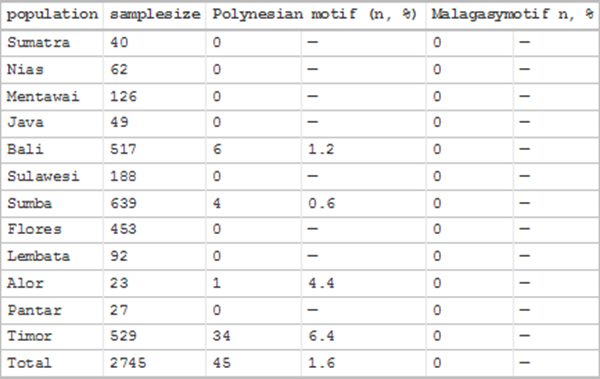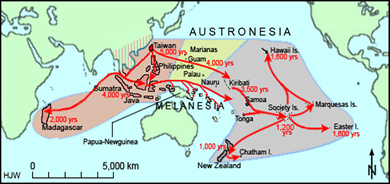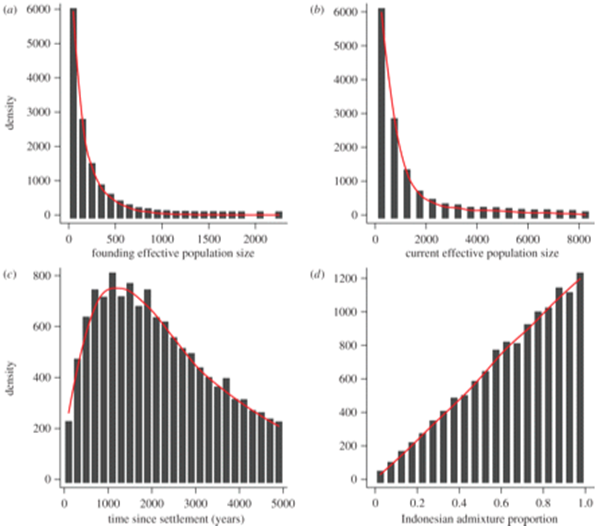Left: Madagascar. Right: The Malay (Austronesian) World
Madagascar may seem a distant place or unknown to some, but no so to the Malays or Malaysian historians. It is an integral part of the Malay World (also referred to as Nusantara, Malayo-Polynesia or Austronesia as mainstream western historians term it). The Malay World was the largest geographical territory prior the modern era, spanning approximately 60% the circumference of the earth. It is a land-and-sea continent stretching across two huge oceans, which itself is testimony to the great sea-faring or ocean-going sailing skills of the Malays.
According to the book The Malay Civilization:
The Malays were the most widely-dispersed ethnic group in the world in pre-Columbus times. Christopher Columbus led the first Europeans out to sea and found a new continent - America - in 1491. Subsequently more European expeditions left the shores of Europe to discover ‘new’ lands in the Americas, Africa, Asia and the Pacific Ocean, and European colonies were also established that brought Whites to settle in the ‘new’ continents. Before such European settlements, the Malays were the only people dispersed across the vast oceans. The Malays are a racial stock with immense internal diversities, distributed across two-thirds of the southern hemisphere from the huge island of Madagascar in the far west of the Indian Ocean to the little Easter Island in the far east of the Pacific Ocean. This large racial stock was once given the over-arching name Malayo-Polynesian. Later, the name Austronesians (‘Islanders of the South’) became used instead, a term which perhaps was considered less cumbersome and perhaps more precise, given the southern island location of the Malay world and indeed the origin of the Malays, in relation to the continental Asian land mass…
….
Today the Malays in very diverse ethnic and sub-ethnic groups are found in a vast world extending continuously from Madagascar off the east African coast in the west, through the vast Malay Archipelago in Southeast Asia, to the Hawaiian islands and Easter island in the far east of the Pacific Ocean and to New Zealand and the Chatham islands in the deep south of the Pacific Ocean and to Taiwan in the north, in all covering about 2/3 of the southern hemisphere. Numerous linguistic studies, mainly done by Europeans since the 19th century, have firmly concluded the unity of these peoples in one language family…
(Mohd Arof Ishak, The Malays Civilization, Kuala Lumpur: Persatuan Sejarah Malaysia, 2007, p. 4, p. 33)
It is a well known fact, mainly through linguistic studies, that the present native Malagasy people of Madagascar are Malays and that, according to prevailing theory, Madagascar was settled as a large-scale planned colonization event from the Malay World.
Now a new genetic study by the journal Proceedings of the Royal Society B reveals that Madagascar was founded, perhaps accidentally, by a small group of women. The following is the gist of its findings:
1. Madagascar was founded or settled 1200 years ago by very small group of women (approx. 30), mostly of Indonesian (Malay) descent (approx. 93%) as a result of a small, perhaps even unintended, transoceanic crossing.
2. Many Malagasy carry a gene tied to Indonesia (the Malay world).
3. Native Malagasy people today can likely trace their heritage back to the 30 founding mothers of the island.
Regardless of whether Madagascar was large-scale colonization by Srivijaya or founded by a different gender, the latest study provides further proof that the people of the island are Malays in origin.
The study made reference to Indonesia since the people and events concerned are placed in that present-day country. It must be noted however that when Madagascar was founded in the 9th century AD (around 830 AD), there were no nations known as Indonesia, Malaysia or Brunei as they are called today. Hence the term Malay World, Nusantara, or Austronesia would be more appropriate.
Photo Source: Discovery News and Live Science
The following are extracts from the new study.
EXTRACTS FROM THE PROCEEDINGS OF THE ROYAL SOCIETY B
A Small Cohort of Island Southeast Asian Women Founded Madagascar
By Murray P. Cox, Michael G. Nelson, Meryanne K. Tumonggor, François-X. Ricaut and Herawati Sudoyo, Proceedings of the Royal Society B, 21 March 2012.
By Murray P. Cox, Michael G. Nelson, Meryanne K. Tumonggor, François-X. Ricaut and Herawati Sudoyo, Proceedings of the Royal Society B, 21 March 2012.
Abstract
The settlement of Madagascar is one of the most unusual, and least understood, episodes in human prehistory. Madagascar was one of the last landmasses to be reached by people, and despite the island's location just off the east coast of Africa, evidence from genetics, language and culture all attests that it was settled jointly by Africans, and more surprisingly, Indonesians. Nevertheless, extremely little is known about the settlement process itself. Here, we report broad geographical screening of Malagasy and Indonesian genetic variation, from which we infer a statistically robust coalescent model of the island's initial settlement. Maximum-likelihood estimates favour a scenario in which Madagascar was settled approximately 1200 years ago by a very small group of women (approx. 30), most of Indonesian descent (approx. 93%). This highly restricted founding population raises the possibility that Madagascar was settled not as a large-scale planned colonization event from Indonesia, but rather through a small, perhaps even unintended, transoceanic crossing.
Selected Illustrations
1. Demographic models
2. A small cohort of Island Southeast Asian women founded Madagascar
 |
| Table 1: Allele frequencies of the Polynesian and Malagasy motifs across the Indonesian archipelago. |
 |
| Table 2: Maximum-likelihood estimates (MLEs) and 95% CI of demographic parameters inferred for the Malagasy settlement model. |
Discussion
An extensive body of genetic, linguistic and anthropological research has now painted a picture of Malagasy history in broad brushstrokes. Humans reached Madagascar only relatively recently. In fact, Madagascar was among the last places on Earth to be settled - archaeological evidence suggests that the first sustained colonization did not occur until the middle of the first millennium AD. Today, Malagasy show clear evidence of genetic and linguistic contributions from Africa. Loanwords suggest contact with the Bantu-speaking peoples of east Africa, but the exact origin of these African settlers remains largely unknown. Contact with populations north of the Zambezi River is typically favoured. Complementing this African connection, evidence from multiple fields of study shows clear and substantial contributions from the Indonesian archipelago. The exact geographical provenance of this contribution is again unclear - arguments have been advanced for both west Indonesia (Ma'anyan language; Sanskrit, Malay and Javanese loanwords) and east Indonesia (South Sulawesi loanwords; prevalence of the Polynesian motif). The presence of Indonesian mtDNA and Y chromosomes in Madagascar argues for a mixed-sex founder population, and this Indonesian genetic component reaches substantial frequencies among Malagasy even today. Similarly, because African and Indonesian lineages differ little across all Malagasy ethnic groups screened to date, the main episode of African–Indonesian admixture likely occurred at the very beginning of Malagasy history.
Key detailing was recently added to this picture. The Polynesian motif in Madagascar carries two derived polymorphisms (1473 and 3423A), and this new haplotype - termed the Malagasy motif - is present in all Polynesian motif carriers screened in Madagascar so far. However, the distribution of the Malagasy motif outside Madagascar has been unclear. Here, we show that this lineage is not widely distributed in Indonesia. Indeed, the Malagasy motif was not detected in 2745 individuals drawn from across the Indonesian archipelago - the largest Indonesian population dataset analysed to date. Even the Polynesian motif, the ancestral lineage of the Malagasy motif, is rare in Indonesia (2%), and with sporadic exceptions, this haplotype is restricted to eastern parts of the archipelago. It remains possible that the Malagasy motif may yet be found in a few small Indonesian communities, perhaps on the relatively understudied islands of Borneo and Sulawesi. Broader sampling in these regions will eventually answer this question. Alternately, the Malagasy motif may not be present in Indonesia at all. Perhaps it arose among the earliest Indonesian colonists to Madagascar, subsequently sweeping to high frequency either in Madagascar or somewhere along the path of their travel (e.g. putative stopping points along the east African coast). In either case, these scenarios hint at a substantial Indonesian founder event during the main settlement period in Madagascar, with strong genetic drift raising the frequency of the Malagasy motif to the elevated levels observed in Madagascar today.
To infer the parameters of this settlement model in more detail, a statistical simulation model was built around the unusual genetic patterns observed in the Malagasy/Indonesian mtDNA dataset: (i) a low frequency of the ancestral Polynesian motif lineage in Indonesia; (ii) two polymorphisms distinguishing the Polynesian and Malagasy motifs; and (iii) a high frequency of the derived Malagasy motif in Madagascar. We set out to ask: what range of settlement model parameters produce genetic patterns like the ones we observe?
Our coalescent modelling suggests several answers to this question. First, although the observed pattern of genetic diversity is relatively uncommon, it occurs more frequently under certain demographic parameters. Coalescent simulations best support settlement of Madagascar beginning around AD 830. This date is consistent with evidence from linguistics, which links the colonization of Madagascar to the expansion of Indonesian trading networks during the Srivijaya Empire. Srivijaya reached its peak in the ninth century, but remained a major maritime power in the Indian Ocean until well into the thirteenth century, consistent with the time frame suggested by our simulations. Our estimates also support a model in which Madagascar was settled by a small effective founding population - estimated at only approximately 30 women, most of whom had Indonesian ancestry (93%). Although this number of founding women might seem surprisingly small, it fits well with estimates of the small number of women (approx. 70) who founded New Zealand, another island nation settled by related Austronesian speakers at around the same time period. In contrast with the simulations of Tofanelli et al., our more complex inferential modelling shows that founder events and drift dynamics are sufficient to explain the frequencies of the Polynesian and Malagasy motifs in Indonesia and Madagascar. Tofanelli et al. employed a one-deme model, simulated only a small range of founding population sizes and fixed (rather than inferred) the Malagasy growth rate. Although they simulated genetic drift, it is not clear that they explicitly modelled the Malagasy founder event. In comparison, our multi-deme simulation framework is far more exact about the colonization event itself. Our highest likelihood model describes a settlement process in which relatively few women, most travelling from Indonesia, founded the Malagasy population - with a much smaller, but just as important, biological contribution from Africa.
This is the first genetic analysis where statistical bounds have been placed on the demographic parameters of Malagasy settlement. The most likely model favours a small founding population, which brings into question the broader context in which the settlement of Madagascar took place. A recurring hypothesis is that Indonesian maritime traders initially settled Madagascar, either as a single colonization event or via repeated settlement waves from the same source population (a process known to the Malagasy as ranto). Indeed, merchants have plied coastal Indian Ocean trade routes between east Africa and northern China at least since the Roman era. However, early written records imply that these trading voyages were dominated by men; there is no mention of women on board long-distance trading vessels. There is no clear evidence suggesting that Madagascar was settled in multiple waves, but because ranto is mentioned in traditional Malagasy narratives, this may be a profitable direction for future simulations.
An alternative hypothesis is that Madagascar was settled as a formal trading colony, perhaps under the auspices of the Srivijaya Empire (although Malagasy are not Hindu today), and possibly resembling later Arab trading centres in the region. Or perhaps Madagascar was settled as an ad hoc centre for refugees, drawn from those who lost land and power during the rapid expansion of Srivijayan influence. Such colonies would be established to be self-sufficient, and therefore, might be expected to include Indonesian women. However, there is little evidence - historical, archaeological or biological - of other Indonesian bases around the Indian Ocean, including the east African coast, although there may have been a Malay trading post in what is now Sri Lanka. Founding such a centre in any official capacity on Madagascar - at the far extreme of Indonesia's trading reach - therefore seems out of keeping with contemporary Indonesian trading practices. Along related lines, historical documents leave no record of refugees fleeing the Srivijaya Empire, although early chroniclers seldom paid attention to powerless groups as these refugees would likely have been.
A third hypothesis is that Madagascar was settled via a direct sailing route across the Indian Ocean, perhaps even as the result of an unintended transoceanic voyage. This view is traditionally considered unlikely, but has recently been revived based on seafaring simulations using ocean currents and monsoon weather patterns. Indeed, during the Second World War, wreckage from ships bombed in the vicinity of Sumatra and Java later washed up in Madagascar, including - in one instance - a survivor in a lifeboat. Cargo ships were substantial vessels during the first millennium AD - up to 500 tonnes and manned by over 100 sailors. It is therefore not beyond the realms of possibility that a single wayward vessel might have effected the settlement of Madagascar. This would certainly be consistent with the extremely small initial size of the Malagasy population, although perhaps not with the mixed-sex founding group suggested by Malagasy genetics.
Without further evidence, the exact nature of Madagascar's settlement must necessarily remain unresolved. Nevertheless, we can now place the settlement process on a much firmer statistical footing. Malagasy are the children of both east and west, with clear Indonesian and African antecedents. Madagascar was settled approximately 1200 years ago, primarily by a small cohort of Indonesian women, and this Indonesian contribution - of language, culture and genes - continues to dominate the nation of Madagascar even today.
For more non-academic reports, read the related articles below.
Related Articles:
1. Madagascar Founded By Women
2. 30 Indonesian Women (Accidentally) Founded Madagascar
1. Madagascar Founded By Women
2. 30 Indonesian Women (Accidentally) Founded Madagascar



No comments:
Post a Comment
Please adhere to proper blog etiquette when posting your comments. This blog owner will exercise his absolution discretion in allowing or rejecting any comments that are deemed seditious, defamatory, libelous, racist, vulgar, insulting, and other remarks that exhibit similar characteristics. If you insist on using anonymous comments, please write your name or other IDs at the end of your message.